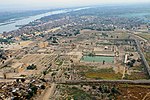Temple of Amenhotep IV
The structures within the Temple of Amenhotep IV at Karnak in Luxor, Egypt, were used during the first four years of the reign of the Egyptian Pharaoh Akhenaten, when he still referred to himself as Amenhotep IV, although they may have been constructed at the end of the reign of Amenhotep III, and completed by his son, the future Akhenaten.[1]
Location and layout
Constructed outside the boundaries of the Precinct of Amon-Re, to the east, the main temple in the complex was named Gm–p3–itn (Gempaaten), which means "The Sun Disc is Found in the Estate of the God Aten". The others were named Hwt–bnbn (Hwt benben / "The Mansion of the Benben stone"), Rwd–mnw–n–itn–r–nḥḥ (Rud-menu / "Sturdy are the Monuments of the Sun Disc Forever"), and Tni–mnw–n–itn–r–nḥḥ (Teni–menu / "Exalted are the Monuments of the Sun Disc Forever").
Very little of these buildings remains, they were built quickly, using Talatat blocks, and could therefore easily be demolished and reused as core for later structures.
Gempaaten

The Gempaaten appears to have no roof and its offering tables were exposed to direct sunlight. In this building (or associated with it) were red granite and sandstone statues of Akhenaten, red granite offering tables and other statues, including a sphinx inscribed with the name of the Aten. It was of a considerable size (130m x 216m), but it was so completely destroyed that its foundations have been nearly obliterated.[2] It stood within a mud-brick enclosure, and was orientated to the east, with possibly an entrance to west, leading to an open court surrounded by square pillars and colossal statues of Akhenaten and Nefertiti.[3]
Hwt benben
Erected in east Karnak, the Hwt benben or Mansion of the Benben was devoted to a solar cult, and was closely associated with the Gempaaten.[4]
Teni-menu
The Teni–menu seemed to contain domestic and storage rooms, and may have been a royal residence, although not enough of the structure remains to clarify the use.[1]
The walls of the Teni-menu were reused in the Ninth Pylon of the main Karnak temple. They have since been identified and reassembled like a giant puzzle and are partly exhibited in the Luxor museum. The scenes show residential, administrative and royal temples and solar Jubilee scenes of the first Sed-festival, Akhenaten was probably celebrating at the same time as his father, and when the Queen Tiye attended.
References & notes
References
Further reading
- Blyth, Elizabeth (2006). Karnak: Evolution of a Temple. Oxford: Routledge. ISBN 0-415-40487-8.
- Donald Redford, Akhenaten : The Heretic King, Princeton, 1984


